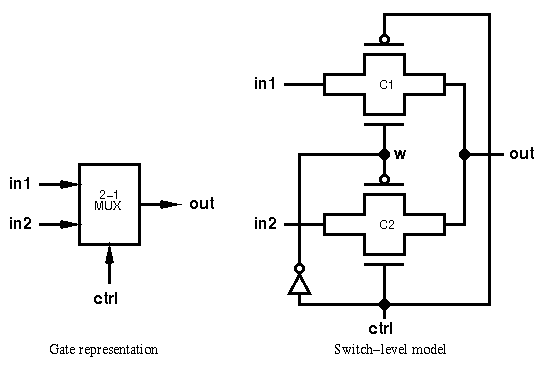This section provides two examples of implementing circuit designs at switch-level.

The switch-level description has a similar structure to that of the behavioural, functional or gate level codes, as in this example of a CMOS inverter:
// Switch-level description of a CMOS inverter module inv_sw (out, in); output out; // inverter output input in; // inverter input supply1 power; // "power" connected to Vdd supply0 ground; // "ground" connected to Gnd pmos (out, power, in); // instantiate pmos switch nmos (out, ground, in); // instantiate nmos switch endmodule
Connection to the Vdd power supply is made using the supply1 net, declared as "power". Similarly, the "ground" terminal is connected to the supply0 net.
Using the pmos and nmos switch-level primitives the respective transistors are instantiated, based on the terminology shown in the previous section. Note that the instance name is optional, and has been omitted in this example.

This circuit assigns the output out to either inputs in1 or in2 depending on the low or high values of ctrl respectively.
// Switch-level description of a 1-bit 2-1 multiplexer // ctrl=0, out=in1; ctrl=1, out=in2 module mux21_sw (out, ctrl, in1, in2); output out; // mux output input ctrl, in1, in2; // mux inputs wire w; // internal wire inv_sw I1 (w, ctrl); // instantiate inverter module cmos C1 (out, in1, w, ctrl); // instantiate cmos switches cmos C2 (out, in2, ctrl, w); endmodule
An inverter is required in the multiplexer circuit, which is instantiated from the previously defined module.
Two transmission gates, of instance names C1 and C2, are implemented with the cmos statement, in the format cmos [instancename]([output],[input],[nmosgate],[pmosgate]). Again, the instance name is optional.
Prepared by: Chun Hsiung Ng Last updated: 23 January 1997